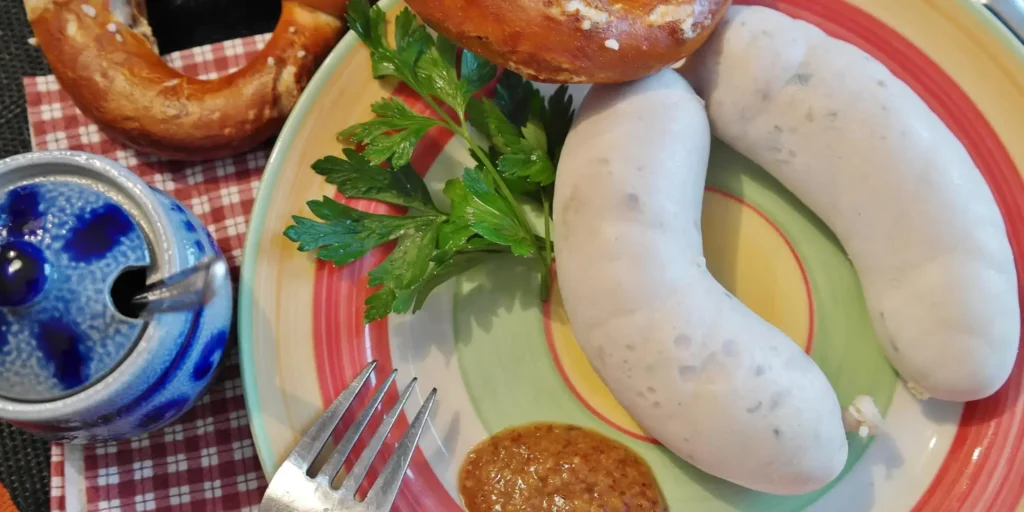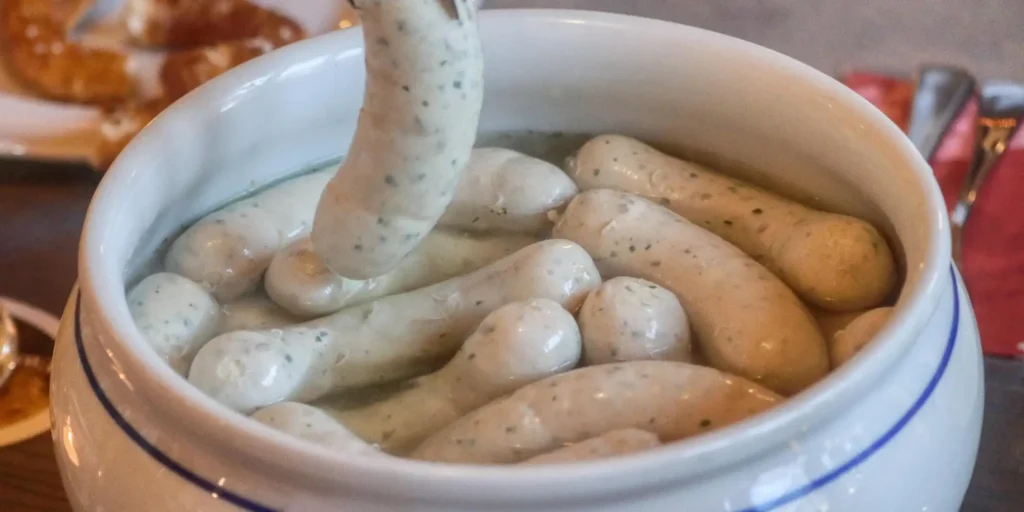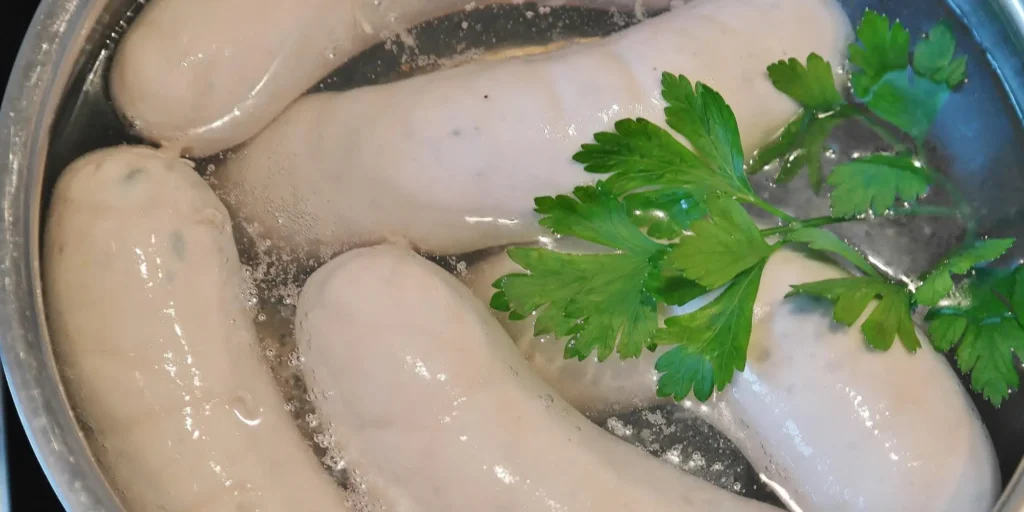Food
Weißwurstfrühstück at the Viktualienmarkt.
A visit to Munich also includes a traditional Weißwurst breakfast! Munich’s most famous specialty is traditionally served in the morning with sweet mustard, pretzels and a hearty wheat beer.
White sausages don’t hear the 12 o’clock chime!
This recommendation dates back to the days when cooling freshly prepared veal sausages was a problem. To prevent the white sausages from going bad, they should be on the plates by 12 noon on the same day. Another explanation is that the white sausages were served in the morning in pubs, mainly to craftsmen, so that they could free up their seats for the more affluent customers at lunchtime. This tradition has now softened somewhat, but some restaurants still only offer the Weißwurst breakfast until 12 noon and most Munich residents only order their Weißwurst until noon.

Never order white sausages in pairs!
To ensure that you order veal sausages in the proper style, you should only order them by the piece. Regardless of whether you order veal sausages in a pub or from a butcher, tradition has it that they are only ordered by the piece. It is said that this rule dates back to a time when white sausages were placed individually in the steaming pot and the waiter was not supposed to confuse anyone when calling to the kitchen. For this reason, the quantity of white sausages was called out in pieces.

How many Weisswurst per person?
How many white sausages should be prepared or ordered in a restaurant per person? How many veal sausages are eaten depends on several factors, of course, but for most white sausage breakfasts a number of between two and three veal sausages per person has proven to be sufficient – after all, the classic accompaniment is also pretzels and, if you like, obazda.
| persons | Weisswurst |
|---|---|
| 1 | 3 white sausages |
| 2 | 5 white sausages |
| 3 | 8 white sausages |
| 4 | 10 white sausages |
| 5 | 13 white sausages |
| 6 | 15 white sausages |
| 7 | 18 white sausages |
| 8 | 20 white sausages |
| 9 | 23 white sausages |
| 10 | 25 white sausages |
History of the white sausage
According to tradition, the veal sausage was invented by chance. On Shrove Sunday, February 22, 1857, Joseph Moser, the butcher and landlord of “Zum ewigen Licht” on Munich’s Marienplatz, ran out of sheep intestines for the veal sausages. He sent the apprentice out, but he came back with pig intestines. As the guests were already waiting, he filled the finished mixture and scalded the sausages in water for fear that the pig casings might burst during frying. On the other hand, an engraving from 1814 was found depicting a Munich man making a sausage and a butcher’s handbook from that time contains a note that the Weisswurst is a less spicy Maibock sausage and contains less pork.

Correct preparation of white sausages
Today’s white sausages are pre-scalded by the butcher and only need to be heated in hot water. You have to be careful here, because the sausages must not be cooked, otherwise they will burst.
How to cook your veal sausages step by step:
- Bring a pan with plenty of water, a little salt and parsley to the boil.
- Once the water has boiled, remove the lid and switch off the stove.
- As soon as the water stops bubbling, the sausages can be placed in it.
- The white sausages are heated in hot water for approx. 10 to 15 minutes and then taken out of the pot piece by piece and served fresh on the plate.
Eating white sausages properly – “zuzeln”, cross-cut and lengthwise cut
This is where the wheat is separated from the chaff, even for die-hard Munich locals. Traditionally pulled, stylishly cross-cut or classically sliced lengthwise. The only thing that is unanimously clear is that the skin of the sausage is not eaten, as it is considered too tough.
Weisswurst zuzeln
Traditionalists enjoy the Weisswurst by hand and gently pull the sausage meat out of the casing with their tongue and teeth. Of course, the sausage is dipped in sweet mustard beforehand. Beginners bite too hard so that the skin tears – practice makes perfect. Critics, including master butchers, complain that this method is “unaesthetic and unappetizing” and that you can’t get all the sausage meat out of the skin. If a white sausage can be pulled, then it has too much fat and water, the critics continue.
Cross-cut of the white sausage
The most elegant way to eat a veal sausage is the cross-cut. The sausage is cut at an angle and the skin is removed with a twisting motion. For experts, the remaining skin creates a diamond pattern on the plate. This is sometimes noted with admiration by the waiters.
Longitudinal cut of the white sausage
The easiest way to eat a veal sausage with a knife and fork is to cut it lengthwise. To do this, the sausage is cut open lengthwise with a knife at the belly and the two halves are removed from the skin. It can then be cut into bite-sized pieces like a normal sausage and eaten with sweet mustard.
Ingredients
In contrast to other sausages, white sausage – as the name suggests – is white to gray. The reason for the colour is that it is only seasoned with table salt and not with pickling salt, which gives other types of sausage their red colour. Munich white sausages are made from veal, pork back fat, cooked veal head meat, ice cream and seasoned with table salt, parsley, pepper, lemon powder, mace, onions, ginger and cardamom. The lean meat must predominate, the skin must not exceed 10 percent, the water must not exceed 25 percent and the fat content must not exceed 30 percent.
